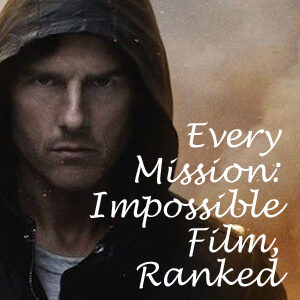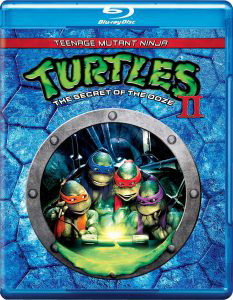I thought “Teenage Mutant Ninja Turtles II: The Secret of the Ooze” (1991) was such a cool movie when it came out, largely because of Vanilla Ice. I wasn’t a fan beforehand, but “Ninja Rap” was catchy, and I figured that rap music was edgy and therefore gave a certain cachet to the film.
Of course, coolness is subjective, and it fluctuates — for example, Vanilla Ice was cool in early 1991, uncool within a year, briefly cool again when he reinvented himself as a rocker, then uncool again, and today unquestionably cool because he recently appeared in a TMNT mac-and-cheese commercial and an episode of “Toy Hunter” where he wore a Turtles T-shirt.
Drawing from Issue 4
More problematic, coolness isn’t enough to build a movie on. “TMNT II” has a remarkably thin plot even by the standards of superhero flicks. In my review of the original 1990 movie, I noted that the plot draws from at least seven comic-book issues. The sequel draws from only one, Issue 4, which finds the Turtles infiltrating the TCRI building. (Well, I guess one could argue that Raph’s scouting of the Foot’s junkyard location comes from Issue 1.)

“Teenage Mutant Ninja Turtles II: The Secret of the Ooze” (1991)
Director: Michael Pressman
Writer: Todd W. Langen
Stars: Paige Turco, David Warner, Ernie Reyes Jr.
The infiltration of the building is done more compellingly and mysteriously in the comic (in the movie, they just waltz right in; in the comic, they trick the security cameras with fake pigeons), there’s more at stake in the comic (Splinter is being held by TCRI in the comic; the Turtles just want information in the movie); and in general, there truly is a “secret” behind the ooze in the comic – alien brains purposely created it for experimental purposes.
Mirage Comics would go to tell stories relating to the Utroms and the ooze well into the 2000s. In the movie, which has no aliens or outer-space element (hence, Techno-“Global” Research Industries instead of “Cosmic”), the secret is … wait for it …
The ooze was created by accident.
One last (movie-length) scare
Donatello, who hopes he’ll find out he and his brothers are special, isn’t the only one let down by that non-bombshell. It’s a symptom of the whole problematic movie: There’s no narrative or character growth. “TMNT II” is simply the horror-movie style “one last scare,” except instead of it happening at the end of the first movie, it becomes its own 85-minute film a year later.
Indeed, the sequel takes place mere hours – maybe a day at the most — after the events of the first movie, as evidenced by the scene where a bunch of ragged-looking Foot soldiers meet up at the junkyard, their fallback spot.
(Then again, the fact that April and the gang are settled in her new apartment to the point where she has a pizza-ordering and noisy-aerobics reputation puts the film at several months later. One possible explanation is that the “Shredder’s return” sequence takes place before the sequences shown before it.)

‘Hey dude, this is a cartoon’
Whereas the first film arguably lives up to its tagline of “Hey dudes, this is no cartoon!,” the sequel (officially taglined “Back by bodacious demand!”) could be described as “Hey dude, this is a cartoon.” It opens with playful music and shots of New Yorkers enjoying huge slices of pizza.
John du Prez is back, but he isn’t tasked with creating any dark and moody music for the sequel. It’s all playful and stylized, as are all the fight scenes, even when it seems plausible that the Turtles could die (as with the row of sharp objects Shredder intends to drop them on, or the dock collapse at the end).
Shredder and his “Let’s make some mutants to fight the Turtles, because it’ll be ironic” scheme are so cartoony that it’s hard to imagine “Shredder’s Suite” playing behind this guy. I mean, it’s a funny scene when Tokka and Rahzar call him “Momma,” but let’s face it, there’s no stalking around to “Shredder’s Suite” after that debacle.
Green and on the screen
In addition to rap superstar Vanilla Ice, two early ’90s societal elements find their way into “TMNT II,” causing the film to age much more poorly than its timeless predecessor. First, there’s the environmental element. Although Professor Perry (David Warner) seems like an OK guy, it’s hard to see TGRI as anything but a big corporate polluter that dodges media investigations.
They create the ooze by accident, lose a canister by accident (leading to the Turtles’ and Splinter’s mutations 15 years in the past), sloppily bury the canisters and now have to dispose of them in a more efficient manner thanks to leakage that creates oversized dandelions. Perry acts sketchy when interviewed by April, using the “Well, would you look at the time!” excuse.
Later, we see that the Turtles – presumably Mikey, but possibly Don — have set up a recycling station in their new abandoned-subway lair: “Recycle dudes! Keep it green and keep it clean.” A valid message, but it’s delivered in shallow fashion (although shallow-subtle is better than shallow-preachy, as is the case with many “TMNT” Archie comics).
Watchdogs win
Second, “TMNT II” represents a complete kowtowing to criticism from parental watchdog groups that the first film is too violent. The most obvious example is the sequel’s opening fight against a pack of shopping-mall burglars where Mike uses sausage links instead of nunchucks. But all the fights are light-hearted, as noted by both the music and choreography.
Don may step up to a pair of Foot soldiers with his bo at the ready, but ultimately he just tricks his adversaries into running into each other. I think the film’s most extended use of a ninja weapon occurs when April tries to convince Keno that she “like(s) to do a little ‘chucking every now and then.” (“I’d keep practicing,” he deadpans after witnessing her sorry display.)
Furthermore, some theorize that Keno (talented martial artist Ernie Reyes Jr., who is does costumed Turtle stunts in the first film) replaced Casey Jones as a way to tone down the violence, and it’s also a popular view that Judith Hoag turned down reprising her role after reading the weak script, thus leading to the casting of daytime soap veteran Paige Turco as April.
April is still a strong-willed independent thinker — she doesn’t accept her boss’ assignment of “A Look Ahead: Swimsuits of the Nineties” – but nor does she grow as a character. No one does. It’s also notable that Raph almost totally loses his edge; at least he disobeys Splinter and infiltrates the Foot, but he pals around with his brothers way too comfortably considering that this movie takes place immediately after the first one.
At least it’s quotable
Now, if I were to look at “TMNT II” strictly for what it is – a light, quip-filled romp – it succeeds. There are tons of delightfully goofy lines that I and my sister used to quote all the time, some of them put in there by writer Todd W. Langen, some of them unintentionally funny.
For example, in the TGRI laboratory “battle” (actually an extended football parody, complete with the Turtles huddling and drawing up a play), a surprisingly fat Foot soldier catches the ooze canister and gratuitously says “Ah-ha!” Then Mike head-butts him in the stomach and he goes “Oooompppphhh!” The voice cast, although not identical to that of the first film (no Corey Feldman this time), is still good: Note Raph’s Brookyln-accented “Let go uh my ahm, Leo.”
That level of professionalism and polish leads me to believe that “TMNT II” is intentionally at the level it’s at, as the filmmakers respond to what they think the audience wants. (Remember, Langen also scripted the much more layered first movie.) By contrast, “TMNT III: The Turtles are Back … in Time” (1993) seems much sloppier.
And indeed, I absolutely ate up everything about “TMNT II: The Secret of the Ooze” when I first saw it, including Shredder’s promise of doling out his revenge “in small doses, through future mutants.” Even though he changes his mind and uses that vial of ooze on himself mere moments later, I assumed the writers knew that more mutants were the key to good Turtle movies, and that we’d be seeing Leatherhead and the Punk Frogs onscreen in a year.
But even in 1991, even as I relentlessly spun “Ninja Rap” and the other ridiculous songs on the soundtrack, I knew “TMNT II” was a step down in quality for the franchise. Likewise, the filmmakers had to know they were making an inferior product whose pop-culture moment would last about as long as Vanilla Ice’s arena-touring career.

